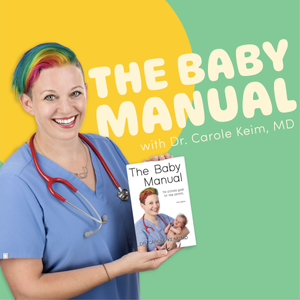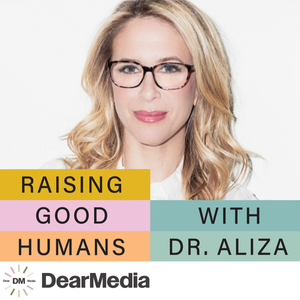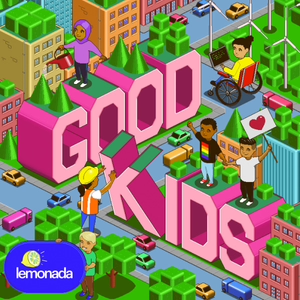
110 - Skin Care
06/01/22 • 22 min
This episode is all about skincare. Dr. Carole Keim MD walks you through the ways newborn skin is different from all other babies’ skin and goes into detail on birthmarks, jaundice, baby acne, eczema, cradle cap, and diaper rash. She explains why newborn skin is prone to dryness and peeling, what milia is and how it will go away on its own, the causes and helps for jaundice, and shares much useful advice.
One of the first things to know about newborn skin is that because they’ve basically been in a bath for nine months, their skin will be dry and peely as it adjusts to the outside world. Have you heard of stork bites, angel kisses, Mongolian spots, or port wine stains? These are all types of birthmarks that Dr. Keim explains in detail. She also details how hemoglobin from extra red blood cells converts to bilirubin in the body, and bilirubin causes the yellowish tint we know as jaundice. Dr. Keim tells exactly what to look for and what to do for your baby.
Covered in this episode:
- Newborn skin
- Newborn rash
- Pustular Melanosis / normal rash
- Milia
- Birthmarks
- Hemangioma
- Jaundice
- Baby acne
- Seborrhoeic dermatitis / cradle cap
- Eczema
- Diaper rash
Newborn skin / newborn rash 0:33
- Dry and peely is normal
- Newborn rash looks a little like chickenpox: red spots all over
- Newborn rash is not itchy or painful and happens usually within first 3 days of life
- No lotion or product required - only a greasy emolient if dry and cracking at wrists or ankles
Pustular Melanosis / normal rash 1:51
- Tends to happen in babies with darker skin tone
- Looks like newborn rash but tiny blisters are smaller - tiny pustules with yellowish fluid inside
- When they pop they leave behind a little freckle
- Freckles go away on their own
- Should go away in a week - if persists beyond week, talk to doctor
Milia 2:44
- Looks like pimples on nose, upper cheeks, forehead
- Is not pimples but is tiny white, pinpoint size, dots
- Do not pick or squeeze, could hurt baby or scar if you do
- It’s essentially skin cells trapped under the skin that form tiny white bumps - almost like clogged pores but not quite
- Will go away on its own and is not dangerous
Birthmarks 3:24
- Present either at birth or a few days or weeks after birth - normal
- Salmon patches - also called stork bites or angel kisses - can show up anywhere on body and usually fade within the first year of life
- Sometimes scalp and back of head salmon patches never fade
- Sometimes when babies cry, especially with patches on forehead or eyelids, they’ll get redder and brighter - this is normal
- Mongolian spots - also called slate grey nevus or dermal melanocytosis - are light blue grey in color, almost like bruises
- They show up frequently from birth in low back area but can really be anywhere
- They tend to fade within the first five years of life
- More common in babies with darker skin tone, normal, and kids outgrow them
- Port wine stains - dark red, flat area of skin - usually on face or upper body, but not always
- Not dangerous but sometimes associated with other conditions
- If your baby has a port wine stain your doctor may want to do a genetic workout but many times it’s nothing
- Treatment is not necessary for port wine stains but some families opt for it for cosmetic reasons
Hemangioma / infantile hemangioma 6:00
- Similar looking to port wine stains but are raised and lumpy
- Are a collection of blood vessels
- If you press on it, it may go lighter colored or white then turn back to red
- Tend to grow quickly - within first 6 months of life - then start to involute or crumble within themselves and shrink back down
- Typically by age four there might be a bit of color left, might not, might be different texture to skin area or might not
- Hemangiomas are often not treated but depending on location may require treatment - hemangioma on eyelid or near airway (“beard distribution” area) could overlay vital structures and cause baby to not see out of affected eye or close airway
- Doctor can check for internal hemangioma with ultrasound
- Treatment may be beta blocker or laser therapy - consult doctor
Jaundice 8:16
- Yellowish color of skin and eyes and is common among babies
- Reason: babies are born with extra red blood cells, some maternal red blood cells release hemoglobin when broken down which converts to bilirubin
- Bilirubin is what causes the yellow color of skin and eyes: jaundice
- Bilirubin can be checked for with tests via light and special device (transcutaneous bilirubin) or blood test (serum bilirubin)
- Phototherapy is brig...
This episode is all about skincare. Dr. Carole Keim MD walks you through the ways newborn skin is different from all other babies’ skin and goes into detail on birthmarks, jaundice, baby acne, eczema, cradle cap, and diaper rash. She explains why newborn skin is prone to dryness and peeling, what milia is and how it will go away on its own, the causes and helps for jaundice, and shares much useful advice.
One of the first things to know about newborn skin is that because they’ve basically been in a bath for nine months, their skin will be dry and peely as it adjusts to the outside world. Have you heard of stork bites, angel kisses, Mongolian spots, or port wine stains? These are all types of birthmarks that Dr. Keim explains in detail. She also details how hemoglobin from extra red blood cells converts to bilirubin in the body, and bilirubin causes the yellowish tint we know as jaundice. Dr. Keim tells exactly what to look for and what to do for your baby.
Covered in this episode:
- Newborn skin
- Newborn rash
- Pustular Melanosis / normal rash
- Milia
- Birthmarks
- Hemangioma
- Jaundice
- Baby acne
- Seborrhoeic dermatitis / cradle cap
- Eczema
- Diaper rash
Newborn skin / newborn rash 0:33
- Dry and peely is normal
- Newborn rash looks a little like chickenpox: red spots all over
- Newborn rash is not itchy or painful and happens usually within first 3 days of life
- No lotion or product required - only a greasy emolient if dry and cracking at wrists or ankles
Pustular Melanosis / normal rash 1:51
- Tends to happen in babies with darker skin tone
- Looks like newborn rash but tiny blisters are smaller - tiny pustules with yellowish fluid inside
- When they pop they leave behind a little freckle
- Freckles go away on their own
- Should go away in a week - if persists beyond week, talk to doctor
Milia 2:44
- Looks like pimples on nose, upper cheeks, forehead
- Is not pimples but is tiny white, pinpoint size, dots
- Do not pick or squeeze, could hurt baby or scar if you do
- It’s essentially skin cells trapped under the skin that form tiny white bumps - almost like clogged pores but not quite
- Will go away on its own and is not dangerous
Birthmarks 3:24
- Present either at birth or a few days or weeks after birth - normal
- Salmon patches - also called stork bites or angel kisses - can show up anywhere on body and usually fade within the first year of life
- Sometimes scalp and back of head salmon patches never fade
- Sometimes when babies cry, especially with patches on forehead or eyelids, they’ll get redder and brighter - this is normal
- Mongolian spots - also called slate grey nevus or dermal melanocytosis - are light blue grey in color, almost like bruises
- They show up frequently from birth in low back area but can really be anywhere
- They tend to fade within the first five years of life
- More common in babies with darker skin tone, normal, and kids outgrow them
- Port wine stains - dark red, flat area of skin - usually on face or upper body, but not always
- Not dangerous but sometimes associated with other conditions
- If your baby has a port wine stain your doctor may want to do a genetic workout but many times it’s nothing
- Treatment is not necessary for port wine stains but some families opt for it for cosmetic reasons
Hemangioma / infantile hemangioma 6:00
- Similar looking to port wine stains but are raised and lumpy
- Are a collection of blood vessels
- If you press on it, it may go lighter colored or white then turn back to red
- Tend to grow quickly - within first 6 months of life - then start to involute or crumble within themselves and shrink back down
- Typically by age four there might be a bit of color left, might not, might be different texture to skin area or might not
- Hemangiomas are often not treated but depending on location may require treatment - hemangioma on eyelid or near airway (“beard distribution” area) could overlay vital structures and cause baby to not see out of affected eye or close airway
- Doctor can check for internal hemangioma with ultrasound
- Treatment may be beta blocker or laser therapy - consult doctor
Jaundice 8:16
- Yellowish color of skin and eyes and is common among babies
- Reason: babies are born with extra red blood cells, some maternal red blood cells release hemoglobin when broken down which converts to bilirubin
- Bilirubin is what causes the yellow color of skin and eyes: jaundice
- Bilirubin can be checked for with tests via light and special device (transcutaneous bilirubin) or blood test (serum bilirubin)
- Phototherapy is brig...
Previous Episode

109 - Tummy Troubles
Does your baby show signs of discomfort after feeding? In this episode, Dr. Carole Keim MD goes over practices to best help your baby through peeing/pooping, gas, colic, and other tummy troubles. If your baby has colic, there are ways to help digestion and alleviate discomfort. Vomiting in infants can be a bad sign; she explains how best to keep your little one hydrated with no treatment for vomiting or diarrhea.
Dr. Carole Kiem MD details different conditions your baby may experience within their first year, such as diarrhea, constipation, vomiting, and reflux. Watch out for blood in the diaper; she goes over the potential causes, from stool to urine or even a “false period” in baby girls. Check out this episode for more information about tummy troubles.
We will cover:
- Pee
- Poop
- Potty training an infant
- Burping
- Gas
- Colic - dx and tx
- Spit ups / GERD
- Vomiting - gastroenteritis, pyloric stenosis, no tx
- Diarrhea - tx, when to be concerned, signs of dehydration
- Constipation
- Blood in the diaper
Pee (0:21)
- Allow up to 24h for the first void.
- A few pees for the first few days; by day 3-5, mom’s milk surges, and baby voids with each feed
- Volume is difficult to discern, and the color is sometimes pale - diapers with urine stripes are helpful.
- Rust-colored urine in the first 2-3 days (uric acid crystals)
- If a baby less than six mos voids less than 6x per 24h or goes more than four h between voids, they may be dehydrated (nighttime doesn’t count!). Babies >6 mos should void at least once per 6h.
Poop (2:48)
- Up to 48h for first stool
- Meconium (and what it means if passed in utero)
- Transitional stools
- Yellow seedy stools
- Over the first 4-6 months becomes brown and toothpaste-consistency
- Formula-fed babies may have brown, yellow, or green stool; tends to be smellier
- Hydrolyzed formula -> gray stools
- Rule of 7’s
- Once they eat food, their poop becomes like adult poop
Potty training from birth / Elimination communication / Diaper-free method (6:27)
- Involves reading baby’s cues and giving cues when it’s time to potty
- Can start as early as birth; I recommend around 1-2mos of age after the discoordinate stooling phase.
- Decide on a phrase and/or hand signal to use
- Bring your baby to the potty (over the sink, potty chair, or toilet adapter)
- Make a sound to indicate it’s time to go (“psss” or grunt)
- Easy catches: babies who go during diaper changes, right after waking up, after eating, when you see them pooping
- It takes several months; ok to wait until later. Toddlers: takes about 6 mos for daytime and another 6-12mos for nighttime.
- I love it because there are fewer diapers, less discomfort for the baby, less diaper rash, and it is easier than toddlerhood.
Burping (12:28)
- How to
- When to (breastfed, formula-fed)
- Why? Decreases gas, colic, spit-ups
- They can stop when they burp on their own (around 4-6 mos)
Gas (14:20)
- Normal to fart a lot, loudly, and have smelly gas
- Breastfed babies may get more gas when mom eats cruciferous vegetables, beans, garlic, and caffeine
- Check with your doctor before you start eliminating foods
- Simethicone - how it works, when to give it, how often
Colic (16:21)
- Rule of 3s: 3h per day, 3 days per week, for 3 weeks
- Almost all babies get some colic symptoms at some point.
- Tummy Time
- Bicycle legs
- Belly massage - clockwise
- Back rubs - counterclockwise
- Medicines: simethicone, probiotics, gripe water; can consider chamomile, licorice, or mint tea - dilute, 1/2oz per day
- Alternative health: chiropractic, acupuncture, ayurveda - I can’t formally recommend them, but they are sometimes helpful; choose your practitioner carefully.
- What doesn’t work - is the sensitive tummy formula. No formula will treat colic.
Spit ups / GERD (20:47)
- Reflux = stomach contents go up into the esophagus.
- GERD = reflux is so bad that the baby has poor weight gain or loses weight, chokes, arches in pain, or has other problems
- LES
- Spit-ups are not forceful.
- Tx: decrease volume and increase the frequency of feeds (BF vs. formula), burp baby well, anti-reflux formula/breast milk thickeners, add 1 tsp rice cereal to 2oz formula/breastmilk (this is the ONLY time we put rice cereal in a bottle), use gravity, medications such as ranitidine make the stomach produce less acid but don’t decrease the volume
- Call your doctor if the baby spits up more...
Next Episode

111 - Sleep
Dr. Carole Keim MD talks you through everything about sleep in this episode. Your baby’s sleep and yours as well. She addresses sleep patterns, helping your baby fall asleep and stay asleep, crying, safe sleep and reducing SIDS risk, and how to consider nighttime work division with a partner so both of you can get your own sleep.
Sleep is vital for both you and your baby. For the first months of your baby’s life, they will sleep a lot in two or three hour increments, and wake to feed often, while you don’t really sleep at all. Dr. Carole offers suggestions on how to help your baby learn the difference between night and day so you can teach that nighttime is for sleep. Develop a nighttime routine for your baby that will help them be ready to fall asleep faster in their crib. Dr. Carole also explains why she’s pro-pacifier and swaddling and cautions about other ideas that may not be safe for your baby. Learn all about your baby’s sleep health so you can get back to your own night rest.
This episode will cover:
- Baby sleep patterns
- How to help baby fall asleep and transfer to the bed
- How much crying is ok
- Safe sleep / SIDS
- Co-sleeping
- Division of night work
- Tips to help you sleep better
- Sleep training
Baby sleep patterns: 00:44
- Newborns: about 18h per day, in 2-3h increments, and MUST be woken up to feed if they have slept 4 hours. NB are only awake to feed/pee/poop/cry.
- Around a month they learn the night-day difference, and will start to sleep longer stretches at night and shorter ones during the day. They still wake at least 1-3x per night and nap throughout the day.
- You can help by interacting more during the day, and keeping the lights dim and a quiet voice at night
- Around 2 months they are allowed to sleep more than 4h at a time; check with your doctor to make sure they are gaining weight consistently
- By 6 months some babies may sleep through the night, but most will still wake up at least once. They are also typically taking 3 naps per day at this age, then 2/day at 9 mos, and 1/day at 1 year.
- It is normal even for the first few years of life to wake 1-2x per night. Can make it less appealing by adding water to the bottle after 1y of age.
- The 4-6mo sleep regression - not a medical thing, may be due to teething. Many babies actually start to sleep better at this age - this is not due to starting solid foods, but more likely due to their ability to consume larger amounts of breastmilk/formula at a time.
- Total hours of sleep: 18h per 24h for newborn scattered throughout the day, 14-18h per 24h for 6 mos old (12-14 at night, then 2-3 naps 1-2h each), 12-14h per 24h for 1 year (11-12 at night, 1 nap for 1-2h)
Help baby fall/stay asleep: 05:43
- Signs baby is tired: drooping eyelids, rubbing eyes, yawning, fussing
- Swaddle baby for the first month or until they bust out of it; can go longer if baby loves it, but MUST stop when baby can roll over
- Have a wind down routine
- Last nighttime feed in arms / high chair
- Brush teeth or gums
- Bath (optional; they don’t need it daily, but it can be relaxing)
- Sway/rock with baby in arms
- Speak in a quiet, soothing voice
- Read a book / sing a lullaby
- Place baby down “awake but drowsy” - they will get used to falling asleep in their bed
- All babies hate their bed!
- If baby falls asleep in arms, transfer quickly to bed, place a hand over them for 10-20 seconds or until they seem settled in, then walk away
- For babies who seem to want more, can sit in a chair near the crib and move the chair progressively farther away each night, eventually stand in doorway while they fall asleep, then you should be able to walk away
- Can try adding in blackout blinds, white noise machine, lotion, etc - keep in mind that baby will get used to this and it can make sleep harder later
- Tylenol/ibuprofen at bedtime for teething infants can help them sleep better
- DO NOT put rice cereal in the bottle for sleep, or start solids early; these actually contain less calories per ounce than breastmilk/formula and will make them get hungry sooner
- DO NOT use melatonin in babies less than a year, or for more than 2 nights in a row after 1 year of age
- DO NOT give your infant or child sedating antihistamines or other sleep medicines, they are not safe
How much crying is reasonable? 12:07
- Most babies will wake up a little as you set them down, and many will cry
- It’s ok to put a hand on them, rock them gently in their bed, pat them gently, talk to them, sing, etc. but try not to pick them up for a few mins
- Generally 5-20 mins of crying is ok, but if it is hard for you to wa...
If you like this episode you’ll love
Episode Comments
Generate a badge
Get a badge for your website that links back to this episode
<a href="https://goodpods.com/podcasts/the-baby-manual-207077/110-skin-care-21655725"> <img src="https://storage.googleapis.com/goodpods-images-bucket/badges/generic-badge-1.svg" alt="listen to 110 - skin care on goodpods" style="width: 225px" /> </a>
Copy




